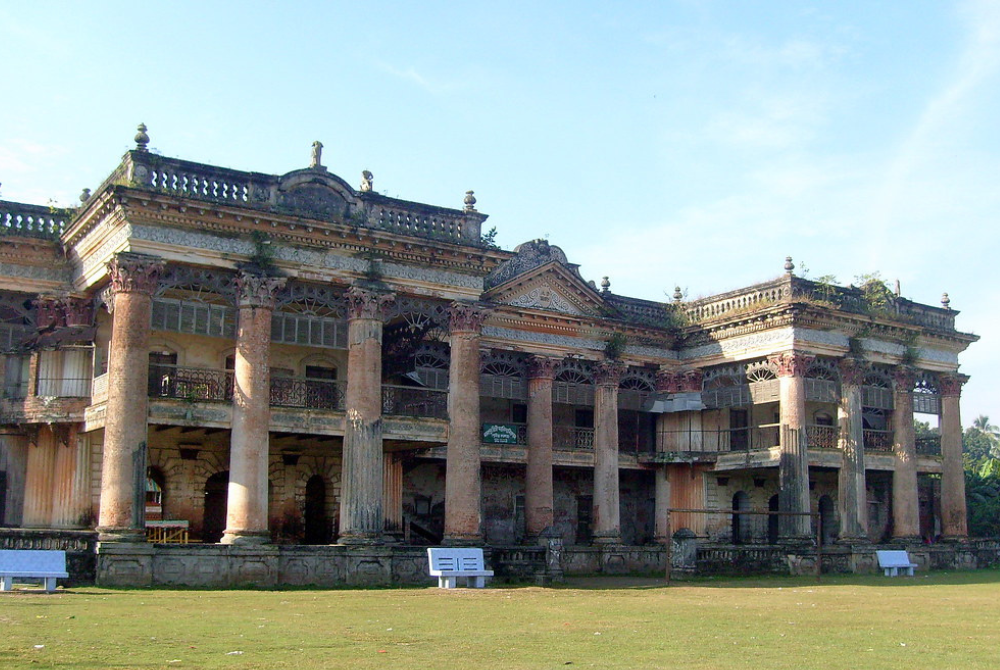Puthia Rajbari Complex
Puthia Rajbari, an architectural gem in Puthia Upazila, Rajshahi, Bangladesh, was constructed in 1895. This magnificent structure, designed in the Indo-Saracenic Revival style, served as the residence for Rani Hemanta Kumari Debi.
Situated just one kilometer south of the Rajshahi Natore highway and 30 kilometers east of the town, this palace has a rich history. Today, it is utilized by Lashkarpur Degree College, albeit in a state of disrepair.
Historical Context of Puthia Rajbari Complex
Puthia, originally part of Laskarpur Pargana, derived its name from Laskar Khan Nilamber, the sibling of the inaugural zamindar of Puthia, who earned the title of Raja from the Mughal emperor Jahangir.
In 1744, the estate underwent a partition, distributing the zamindari among four co-sharers, with the “panch ani” (five annas) and “char ani” (four annas) co-shares gaining renown in zamindari affairs.
Puthia Rajbari Complex Structure
Puthia Rajbari, a historic estate, is surrounded by protective ditches and occupies a significant 4.31-acre tract of land. Located at the southern end of an open field, the estate’s once formidable walls have, unfortunately, suffered damage over time.
This architectural gem is divided into four distinct courts: the Kachhari (office) Angan (court), the Mandir Angan or Gobindabari (temple court), the Andar Mahal (inner quarters), and the residence of Maharani Hemanti Kumari.
Notably, the layout of the rooms within the palace is structured around these courts, with the exception of the Kachari Angan, a one-story structure. The Kachari Angan is particularly striking, featuring Palladian-style porticos on its western and eastern ends, supported by four semi-Corinthian columns. These porticos extend to the first floor, where they house arcaded, semi-glazed loggias, maintaining the columned theme.
Access to the upper floor is provided by a wooden staircase on the eastern side, leading to a series of rooms, including two treasuries. On the west side, the structure offers four rooms with two verandahs. Near Gobindabari, two small rooms with a verandah can be found. Unfortunately, most of the rooms situated to the east and south of Kachari Angan have fallen into disrepair.
In the northern section of the building, which stretches along an east-west axis and spans two stories, there is a spacious hall measuring 21.95m x 7.16m. The upper portion houses six differently designed rooms. A wide verandah with balconies on either side adjoins the hall. Within the Gobindabari section of the palace, one can discover the Pancharatna Bara Gobinda temple, exquisitely adorned with terracotta carvings.
The Andar Mahal boasts two rooms and several bathrooms in its western part. Regrettably, many of the rooms within the western court of Andar Mahal are now in ruins. Meanwhile, in the eastern portion of Andar Mahal, a one-story residence belonging to Rani Hemanta Kumari is situated. This residence features a front porch, a central reception hall with nine rooms, and extended verandahs with arches. The roof construction includes both iron and wooden beams.
Despite the deterioration of certain sections, Puthia Rajbari stands as a testament to its rich historical and architectural heritage, blending classical and regional design elements to serve as a site of profound cultural significance.
The Puthia Rajbari Complex Current Condition
The historic palace in Rajshahi is facing a significant threat to its ornate terracotta artwork, with antiques from various structures deteriorating or being stolen due to a lack of proper care from the archaeological department. Recent research has revealed extensive damage and theft of terracotta pieces from Chotto Anik Temple, Boro Gobindo Temple, and Chotto Gobindo Temple.
The remaining artifacts are also at risk of decay, primarily due to high salinity in the area. Unfortunately, there has been a lack of strong commitment from both the archaeology department and the government to preserve this valuable heritage.
Despite the concerns of locals and experts, no effective measures have been taken to protect the palace and its temples. Shockingly, even a basic boundary wall to safeguard these structures has not been erected in the last 30 years, resulting in cattle freely roaming around the 400-year-old site.
Moreover, there has been no official recognition of the heritage’s importance to tourism, and reports of missing and stolen items continue to surface regularly.

